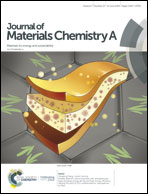Perovskite Na0.5Bi0.5TiO3: a potential family of peculiar lead-free electrostrictors†
Abstract
For perovskite ferroelectric oxides, the composition-induced transition from ferroelectrics to relaxors can enhance their electrostrictive coefficient Q33 remarkably, and has been attracting more and more attention in recent years. Achieving a larger electro-strain response is one of the most original driving forces for pursuing higher Q33 values, while the two are often incompatible. Herein, taking the promising relaxor ferroelectric Na0.5Bi0.5TiO3 (NBT) as the research object, we report the excellent electrostriction-like electro-strain behaviors (0.41% ≤ Suni ≤ 0.46%, 25 ≤ T ≤ 125 °C; Suni exhibits only 2.23% decline after 105 cycles) together with a series of enhanced Q33 values (0.029–0.047 m4 C−2). Accompanied by the reconstruction of de-coupled A–O interactions, the electric-field-induced relaxor to ferroelectric state transition contributes to the superior electro-strain behaviors, while the enhanced Q33 will greatly degenerate during this transition process. In contrast to the non-hysteretic electrostriction observed in linear dielectrics, for NBT-based relaxor ferroelectrics, the peculiar coexistence of ferroelectric in-phase a0a0c+ and anti-phase a−a−a− tiltings is suggested to contribute to the enhanced electrostriction-like behaviors observed in this work. These observations indicate that NBT-based systems can be considered as a potential family of peculiar lead-free electrostrictors for application in the field of actuators.



 Please wait while we load your content...
Please wait while we load your content...